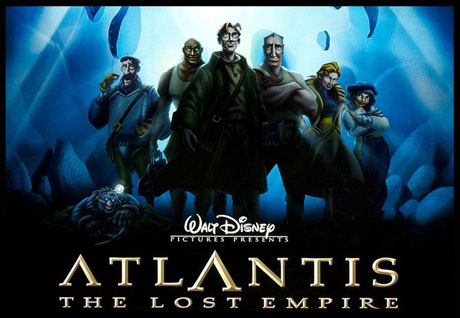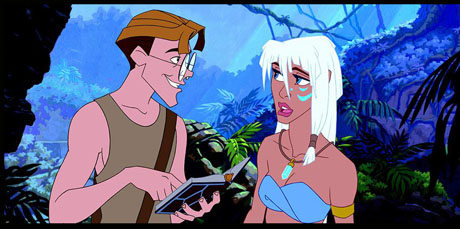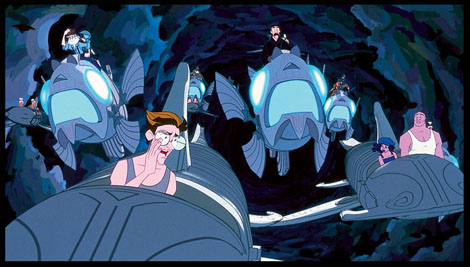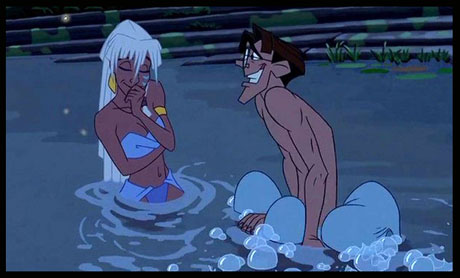
Disney’s 41st animated feature, Atlantis: The Lost Empire, was born at a Mexican restaurant. During lunch in 1996, it was there that producer Don Hahn and directors Kirk Wise and Gary Trousdale (who had all collaborated on Beauty and the Beast and The Hunchback of Notre Dame) met to talk about movies and potential future projects.
One common theme was how much the three filmmakers loved classic Disney live-action films like 20,000 Leagues Under the Sea and Swiss Family Robinson and more recent blockbusters like the Indiana Jones movies.

The three decided that they would love to bring a story like this to animation. By the time Atlantis opened in theaters in the summer of 2001, the studio was coming off an over decade-long run that proved to be a renaissance for animation at Disney. An action-adventure/fantasy would be the perfect antidotes to the musical fairy tales and fables that had come before.
Marking its 20th anniversary this month, Atlantis: The Lost Empire began life as a different story. Initially, the team thought of adapting Jules Verne’s adventure story, Journey to the Center of the Earth. They then shifted to creating an original story that focused on discovering the lost city of Atlantis, mainly when they came across a quote from Plato during the early days of production. The mysterious quote read: “…in a single day and night of misfortune, the island of Atlantis disappeared into the depths of the sea.”
So impactful was that quote that the filmmakers used it on a title card at the opening of Atlantis: The Lost Empire. The film, set in 1914, centers on Milo Thatch (voiced by Michael J. Fox), a linguistic expert who works at the Smithsonian Institution. He is knowledgeable and obsessed about the lost city of Atlantis.

Milo is pulled into an expedition funded by an eccentric millionaire, Preston Whitmore (John Mahoney of TV’s Frasier), who has put together a team to locate Atlantis. They are led by Commander Rourke (James Garner) and include lieutenant Helga Sinclair (Claudia Christian). The large squad is made up of demolition expert Vinny Santorini (SNL’s “Father Guido Sarducci,” comedian Don Novello), Dr. Sweet (Phil Morris), mechanic Audrey Ramirez (Jacqueline Obradors), radio operator Mrs. Packard (Florence Stanley), geologist Gaetan “Mole” Molier (voice acting veteran Corey Burton) and their cook, “Cookie” (Jim Varney in his last screen role).
The crew indeed finds Atlantis, led by the King (Leonard Nimoy) and Princess Kida (Cree Summer). A double-cross from a team member then forces the rest of the crew to band together to save Atlantis.
Atlantis: The Lost Empire had a unique graphic look inspired by comic book artist Mike Mignola, the creator of the popular Hellboy comics. Mignola had a distinct, angular design, which used on the look of the characters, and the artist was brought in as one of the film’s production designers.
Additionally, to make the world of Atlantis even more believable, the filmmakers hired linguist Mark Okrand (who had created Star Trek’s Klingon language) to craft an Atlantean language for the denizens of the lost city.
In addition to outstanding voice work, particularly by Fox, who brings innocence and sympathy to Milo and Garner, whose low, almost growling tones are perfect for Rourke, there is also excellent character animation.

John Pomeroy, who supervised Milo and Randy Haycock, animating Kida, provided impressive acting in their work, as the two characters discover each other and each other’s worlds. Animator Russ Edmonds brings subtle comic timing to Vinny, and Mike Surrey crafts Rourke as an almost immovable force of nature.
Additionally, directors Wise and Trousdale take advantage of the genre, staging several impressive action sequences, particularly in the beginning of the film, when the submarine Leviathan is attacked in an impressive underwater set-piece. In the finale, Milo and the others commandeer Atlantean flying ships in a dizzying dogfight
When Atlantis: The Lost Empire opened on June 15, 2001, it received a lukewarm welcome from critics. Some, like Roger Ebert, raved, giving the film three and a half out of four stars. Others, like Entertainment Weekly’s Owen Gleiberman, weren’t as impressed, giving the film a “C+” rating.
The film also had the misfortune of opening about a month after DreamWorks’ Shrek, which was already experiencing blockbuster success and seemed to take the intended family audience away from Atlantis.

With the film’s disappointing box-office performance, plans for an animated TV series, Team Atlantis, were canceled (several episodes had been produced and were bundled together as the direct-to-video sequel Atlantis: Milo’s Return).
Additionally, Disneyland had plans to redesign its classic “Submarine Voyage” attraction around Atlantis, but, again, as the movie wasn’t as popular as initially hoped, these plans were put on hold. Instead, the attraction became “The Finding Nemo Submarine Voyage,” after Disney/Pixar’s Finding Nemo was a hit in 2003.
While the legacy of Atlantis: The Lost Empire may be challenging to find at Disney theme parks, the film has gained a following in the twenty years since its release among Disney, animation, and science fiction fans, who all feel that the film has been unfairly forgotten.
As time goes on, like the lost city itself, it seems more people discover Atlantis: The Lost Empire.
- An Eye for A Classic: The 60th Anniversary of “Mr. Magoo’s Christmas Carol” - December 22, 2022
- A Very Merry Mickey: The 70th Anniversary of “Pluto’s Christmas Tree” - December 19, 2022
- A Fine French Feline Film: The 60th Anniversary of “Gay Pur-ee” - December 12, 2022


 June 7th, 2021
June 7th, 2021  Michael Lyons
Michael Lyons  Posted in
Posted in  Tags:
Tags: 






